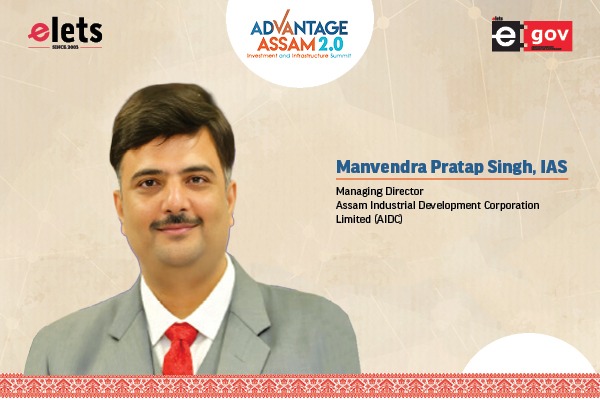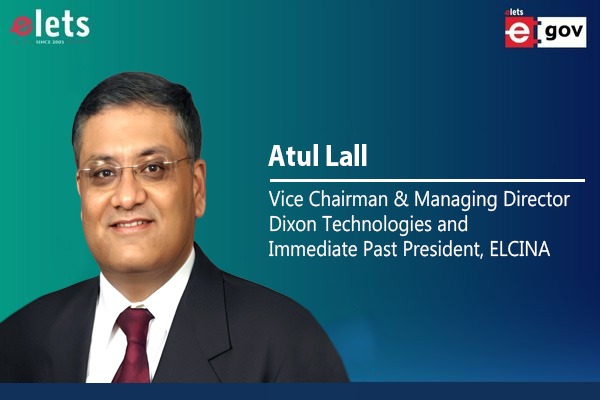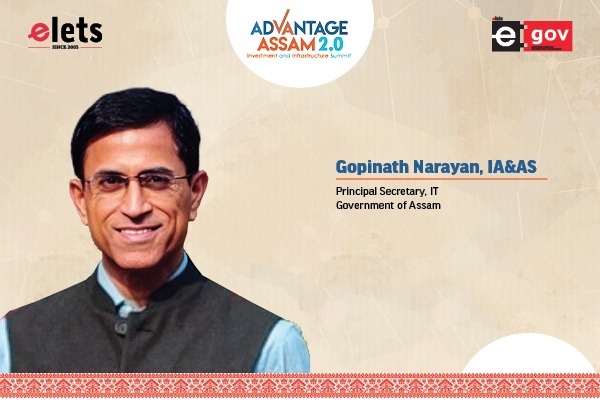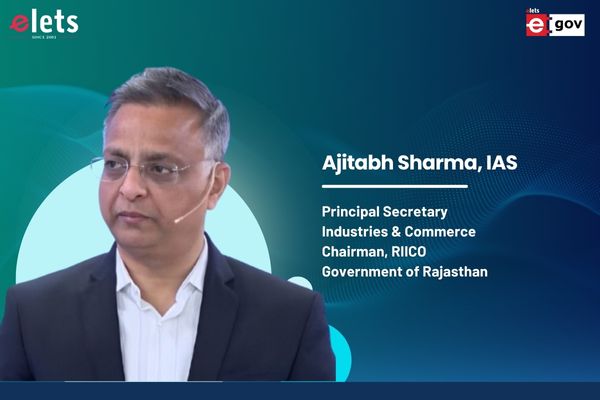
In recent years, Gujarat’s Urban Development Department has launched several key initiatives to bolster urban infrastructure. Under AMRUT 1.0 and 2.0, the state has enhanced water supply, sewage systems, and green spaces. The Smart City Mission has seen 354 projects worth over `11,455 Cr, improving services like traffic management and public Wi-Fi. The Swarnim Jayanti Mukhyamantri Shahri Vikas Yojna invested `42,615 Cr in infrastructure upgrades. Efforts also include affordable housing through innovative technologies and public-private partnerships, addressing urban challenges and promoting sustainability, shared Shalini Duhan, IAS, Deputy Secretary, Urban Development Department, Government of Gujarat, in an exclusive interview with Hemangini Kanth Rajput of Elets News Network.
What are some key initiatives the Urban Development Department took in recent years to improve urban infrastructure in Gujarat?

The Urban Development Department in Gujarat has undertaken several key initiatives in recent years to enhance urban infrastructure across the state. These initiatives are intended to promote sustainable urban development, improve the quality of life for residents, and foster economic growth. Here are some notable initiatives under which the state has upgraded and fostered infrastructure services.

AMRUT 1.0: AMRUT is providing essential services (e.g. water supply, sewage, urban transport) to households and building amenities in cities which improve the quality of life for all, especially people experiencing poverty and the disadvantaged section is a national priority.

AMRUT 2.0: A step towards AatmaNirbhar Bharat aims to make the cities ‘water secure’ and provide functional water tap connections to all households. This will be achieved through a circular economy of water by affecting water source conservation, rejuvenating water bodies and wells, recycling/reusing treated used water, and rainwater harvesting by involving the community.

Smart City Mission: The Government of India launched the Smart City Mission in June 2015 to enhance infrastructure, quality of life, and sustainability. In Gujarat, 354 projects worth over Rs. 11,455 Cr have been initiated; 338 projects worth Rs. 10,793 Cr are completed, and 16 projects worth Rs. 662 Cr are ongoing. Gujarat consistently ranks among the top five states, with all six cities in the top 50 Smart Cities and two cities in the top five nationally.
Swarnim Jayanti Mukhyamantri Shahri Vikas Yojna (SJMMSVY) Under the Swarnim Jayanti Mukhyamantri Shahri Vikas Yojna (SJMMSVY), Gujarat has invested Rs. 42,615 Cr from 2009 to 2022 to upgrade city infrastructure, including water supply, drainage, renewable energy, and urban bus services.
Details on the number of projects executed & grant amount used under the SJMMSVY scheme for the last four financial years are mentioned below:
Renewable Energy: To promote self-reliance and net-zero emissions, the Urban Development & Urban Housing Department plans to install 250 MW and 150 MW renewable energy facilities for Municipal Corporations and Municipalities, respectively. Additionally, efforts are underway to install solar plants at STPs and WTPs to cut electricity costs.
Affordable Housing: Initiatives, such as the Mukhyamantri Gruh Yojana, aim to provide housing for low-income and economically weaker sections, promoting inclusive urban development in Gujarat.
How is Gujarat progressing under the Smart Cities Mission? Could you highlight some specific projects and their impact?
Under the Smart Cities Mission, six cities in Gujarat— Ahmedabad, Surat, Vadodara, Rajkot, Gandhinagar, and Dahod—were selected. A total of 354 projects worth over Rs. 11,455 Cr were initiated, with 338 projects valued at Rs. 10,793 Cr completed and 16 projects worth Rs. 662 Cr ongoing. Key projects include:
- Command and Control Center
- Integrated Transit Management System
- BRTS – Bus Rapid Transit System, various innovative services related to routes
- Easy management of civic amenities
- CCTV Surveillance System
- Water management through SCADA
- Planning of Smart Parking and Traffic Monitoring
- Grievance Redressal Mechanism for Citizens
- Construction of City Square
- Renovation of Gardens
- Modern approach to Solid Waste Management
- Robust Infrastructure
- Slum Redevelopment to Affordable Housing
- City Wi-Fi system
Impact of Projects under Smart Cities
Surat’s Command-and-Control Centre integrates various Departments for real-time monitoring and control, focusing on traffic regulation, surveillance, emergency response, and real-time service tracking. The centre employs advanced intelligent solutions, including a city surveillance system, traffic management system, public Wi-Fi hotspots, Variable Messaging Displays, bright lighting, virtual messaging boards, and a public address system.
Key features include zero tolerance for red light violations with Automatic Number Plate Recognition (ANPR) and the use of traffic congestion and vehicle count data for urban planning and air quality improvement. Surveillance cameras at traffic junctions help identify waterlogging early, preventing traffic jams during the monsoon season.
The Integrated Transit Management System (ITMS) offers a unified IT backbone for real-time monitoring of BRTS fleets, providing a people-centric, environment-friendly, and efficient transport system. This innovative bus system adapts to the city’s growing footfall through IoT and extensive data analysis.
The iLAB Foundation supports various start-ups by offering guidance, incubation facilities, an expert panel of mentors, a joint facility centre, and a professional co-working space. This support has been crucial in transforming innovative ideas into successful ventures.
The Water SCADA project allows remote monitoring of flow and pressure in the water network. Data analysis helps determine actual supply quantities and forecast demand. The project’s dashboard alerts engineers to deviations in key performance indicators, enhancing water supply service delivery.
In Dahod, Chhab Talav and Gardens have been developed as green and water-sensitive public spaces. Six gardens have been rejuvenated, with Chhab Talav being a central feature of public life. The lakefront includes a jogging track, paved pedestrian walkways, street furniture, and activity areas. Other developments include a cycle track, landscaped tree avenue gardens, green spaces, ghats, lake cleanliness initiatives, and water quality improvements through aeration.
Affordable housing is a critical issue in urban development. What measures has the Department taken to address this issue?
Gujarat is one of India’s fastest-growing states, experiencing rapid economic growth and urbanisation. This urban expansion presents significant challenges, particularly in providing affordable housing to new migrants to prevent the proliferation of slums. The Government of Gujarat has proactively launched an ambitious program to rehabilitate slum dwellers and create affordable housing across major urban centres.
Some Affordable Housing Initiatives
Land Pooling Mechanism: The Gujarat Housing Board, Urban Local Bodies (ULBs), and urban authorities provide land for affordable housing at nominal rates. They utilise land banks from ULC surplus land, reserved land for EWS housing in Town Planning schemes, and government lands. A Residential Affordable Housing Zone has been established in Ahmedabad, introducing inclusive planning norms and providing houses with necessary facilities.
Innovative Technologies: Over 50,000 houses have been constructed using new, innovative technologies. Under the Global Housing Technology Challenge (GHTC), Gujarat is one of six states selected to implement a lighthouse project in Rajkot. The project features 1,144 houses worth Rs. 119 Cr, constructed with monolithic concrete using tunnel formwork technology.
Direct Benefit Transfer (DBT): Under the Beneficiaries Led Construction (BLC) program, eligible EWS families receive Rs. 3.5 lakh per house directly into their accounts to construct new homes. This process is monitored through geo-tagging, making Gujarat a frontrunner in implementing the Pradhan Mantri Awas Yojana (Urban). As of January 2023, 9,78,684 houses were sanctioned, with 8,55,279 completed.
Key Milestones of Pradhan Mantri Awas Yojana in Gujarat
- As of January 2023, Gujarat has made significant progress under the Pradhan Mantri Awas Yojana. Against a housing demand of 7.64 lakhs, 8.62 lakh houses were approved, with 7.41 lakh completed. Achievements include:
- Affordable Housing in Partnership (AHP): 1,74,050 units
- In-situ Slum Redevelopment (PPP): 56,955 units
- Credit Linked Subsidies Scheme (CLSS): 4,91,999 units
- Beneficiary Led Construction (BLC): 1,38,614 units
- Houses provided through AHP and ISSR include amenities like PNG gas pipelines, solar rooftops, and social infrastructure. BLC assistance is disbursed directly to beneficiaries via DBT.
Rapid urbanisation brings various challenges. What are Gujarat’s significant challenges in urban development, and how is the Department addressing them?
India’s population, growing at a decadal rate of 17.7%, is on track to make it the most populous nation globally. By 2036, 40% of Indians will live in urban areas, contributing 70% to the GDP. Gujarat, surpassing the national urbanisation rate of 31.16% in 2011 with 43%, is projected to reach 54% by 2031. As urbanisation transforms urban settings, developing physical, social, and digital infrastructure is crucial for sustained growth.
Key Issues and Challenges
- Delineation Problems: Identifying physical limits and boundaries.
- Limited Capacity and Resources: Local authorities need help with quality urban planning and financial constraints. They often rely on panchayats in peri-urban areas that lack financial and technical resources.
- High Infrastructure Needs: Disproportionately high infrastructure demands compared to other city parts.
- Makeshift Arrangements: Reliance on borewells and soak pits.
- Environmental Concerns: Urban flooding, loss of green cover, pollution from MSW and C&D waste, groundwater depletion, and unplanned hardscape.
Visionary Initiatives
Strengthening Urban Infrastructure
- The urban budget has increased 100 times over two decades.
- The “Swarnim Jayanti Mukhya Mantri Shaheri Vikas Yojana” (SJMMSVY) supports essential infrastructure projects like water supply and underground drainage.
Sustainable Urban Development
- Implementation of schemes like Har Ghar Jal, SBM, PMAY Urban, AMRUT, and Smart Cities Mission.
- Focus on solar power, treated wastewater reuse, zero untreated waste disposal, and river/lake revival projects.
Enhancing Urban Mobility
- BRTS is operational in three cities, and METRO is planned to create a multi-modal integrated transport system in major cities.
Inclusive Housing Initiatives
- Recognised for exemplary performance under PMAY (U) with multiple awards.
Digital Governance Reforms
- Town Planning and Valuation Department initiatives include:
Online availability of 400 TP Schemes and 475 more in a year.
105 Cities/Town Development Plans converted to GIS.
Reduced preparation time for development plans.
ODPS 2.0 was launched for centralised online building permission applications, reducing the average processing time from 90 to 28 days.
Gujarat’s commitment to urban development is evident in these initiatives, aiming to enhance the quality of life for its urban population and foster sustainable growth.
How is the department incorporating sustainability and green practices into urban development projects?
Aligned with national sustainability targets, Gujarat’s government has made significant strides in creating livable, green cities. The Chief Minister’s Urban Bus Service (CMUBS) supports green mobility through strategic financing, including viability gap funding, and aims to add 2,864 buses across major cities, including 300 new electric buses.
Launched in 2018, CMUBS covers eight municipal corporations and 22 A-class municipalities. It promotes sustainable mobility and reduces urban transport emissions, which account for one-third of city emissions.
Additionally, Gujarat plans to install 250 MW and 150 MW renewable energy facilities for municipal corporations and municipalities to support net-zero emissions. Solar plants are being set up at STPs and WTPs to cut electricity consumption, furthering the state’s commitment to sustainability and green practices.
Efficient public transportation is crucial for urban areas. What steps are being taken to enhance public transit in Gujarat’s cities?
Efficient public transportation is vital for urban areas. Gujarat is making significant strides to enhance its public
transportation through various initiatives.
The Chief Minister Urban Bus Services (CMUBS) Scheme, launched in 2018, covers municipal corporations and 22 class “A” municipalities. The scheme aims to add 2864 city buses on the Gross Cost Contract Model. Urban Local Bodies (ULBs) receive 50% of the cost as Viability Gap Funding (VGF): up to Rs. 12.5 per km per bus for CNG buses and Rs. 25 per km per bus for electric buses. So far, 1293 buses have been added, including 464 electric buses in major cities like Ahmedabad, Rajkot, Surat, and Gandhinagar.
Nine cities (Mehsana, Porbandar, Morbi, Navsari, Vapi, Bharuch, Surendranagar—Dudhrej Municipalities and Jamnagar Municipal Corporation) have started new city bus services.
New 464 electric buses have been added in four major cities (Ahmedabad, Rajkot, Surat, and Gandhinagar). A total of 793 CNG (660 old replacement and 133 new) buses in 12 cities are being approved (Mehsana, Porbandar, Morbi, Navsari, Vapi, Bharuch, Surendranagar—Dudhrej Municipalities and Ahmedabad, Surat, Vadodara, Jamnagar Municipal Corporation).
The Fleet is of 464 e-Buses so far.
- AMC: 200
- SMC: 119 + 81 (Jan 2023)
- Rajkot: 44
- GMC: 20 (Ahmedabad – Gandhinagar)
An Integrated Traffic and Mobility Administration Centre has been implemented to manage city traffic and mobility, encompassing BRTS, city buses, traffic police, RTO, fire, and emergency services. Key components include:
- E-Challan System: Digital traffic enforcement, generating e-challans worth Rs. 341.53 Cr in six intelligent cities.
- AI-based Road Monitoring: Alerts for traffic congestion, roadblocks, damages, and wrong-side driving.
- Traffic Volume Data Analysis: Understanding traffic trends in various areas.
- Waterlogging Hotspots Identification: 12,000 CCTV cameras were installed across four major cities.
Under the FAME I & II schemes, which support electric mobility, Gujarat has received a sanction for 700 e-buses. This aligns with India’s push towards clean mobility in public transport. These initiatives mark significant progress in enhancing urban transportation in Gujarat.
How does the department engage with local communities to ensure their needs and concerns are addressed in urban development projects?
A participatory approach to urban development is crucial to enhancing cities’ inclusivity, sustainability, and livability. Gujarat has initiated various interventions to foster collaborative and transparent governance systems as a citizen-centric state. Some significant initiatives include:
Common Card Payment System (CCPS) – Jan Mitra Card in Smart City Ahmedabad
The “One Card Many Services” project is a one-stop solution for all payment needs, enabling a multimodal transport journey through a single one-loop card.
Benefits and Outcomes
- Provides transit service ticketing for BRTS, AMTS, airport shuttles, and future metro services.
- Facilitates payments for all municipal services and retail transactions at malls, restaurants, and movie theatres.
- Available at over 100 service delivery points in the city.
- It is currently used by more than 500,000 people.
Citizen Complaint Redressal System (CCRS) in Smart City Ahmedabad
CCRS is a web-based enterprise solution that enhances citizen satisfaction through comprehensive service management and efficient service delivery. It automates the entire complaint process, from registration to closure.
Important Initiatives
- Dedicated Call Center: 155303 Citizen Complaint and Grievance Redressal Call Center.
- Handles over 1,500 calls daily.
- We have customised complaint management system for all zones and wards in Ahmedabad.
- Dedicated mobile app and web link for complaint registration.
Outcomes
- Over 4.5 million complaints registered since the project’s inception.
- Command Centre tracks complaints and manages resolutions efficiently.
- Enforces service-level policies to ensure timely attention to complaints.
Integrated Command & Control Center (ICCC) in Smart Cities
ICCCs have been successfully set up in six major cities of Gujarat to enhance existing service delivery and achieve optimal utilisation of municipal assets. These centres provide robust online infrastructure and 24×7 city-wide wireless connectivity to aid various city operations.
Key Features
- Identifies urban challenges across sectors, including mobility, water supply, sanitation, and security.
- Enables timely actions and builds greater faith and trust among citizens.
e-Nagar Portal
- Launched in 2017-18, the e-Nagar Portal revolutionises citizen services in Gujarat by leveraging technological advancements. It serves as a centralised platform for the smooth delivery of services such as paying professional tax, building use permissions, water and drainage services, and issuing marriage, birth, and death certificates.
Key Features
- Transforms citizen perception of administrative machinery.
- Provides a 24×7 complaint and grievance redressal facility to support citizens and gather feedback for service improvement.
Online Development Permission System (ODPS)
ODPS promotes ease of doing business by setting up a transparent, efficient, and convenient system for streamlining essential services in the real estate sector. Gujarat was the first state to launch ODPS 2.0, which provides single-window clearance for building construction permissions and reduces approval time from two to three months to 48 hours.
Key Features
- Adopts transparency, decisiveness, sensitivity, and progressiveness.
- Creates a thriving urban economic ecosystem.
Can you discuss the role of public-private partnerships in urban development in Gujarat?
Public-private partnerships (PPPs) play a significant role in urban development in Gujarat, as they do in many regions globally. With its dynamic economy and ambitious urbanisation agenda, Gujarat has actively embraced PPPs to leverage the expertise and resources of both the public and private sectors in driving sustainable urban development.
Key initiatives include
- Development of EV stations and bus operations on PPP mode.
- Comprehensive solid waste management in cities.
- First state to implement PPPs for in-situ slum redevelopment under PMAY (U).
- Surat’s pioneering use of treated wastewater generated INR 140 Cr in FY 2022-23 for various purposes.
What are your vision and goals for urban development in Gujarat? Are there any upcoming projects or policies that you are particularly excited about?
Gujarat’s rapidly growing state economy is making strides toward transformative urban changes. The Vision Gujarat@2047 document outlines strategies for developing city agglomerations into vibrant socio-economic centres. Key targets include achieving 100% piped drinking water supply, enhanced per capita water supply, and 100% wastewater recycling or reuse by 2030. The urban budget has increased from INR 175 Cr in 2003 to INR 21,067 Cr for FY 2024-25.
Key initiatives include:
- Establishment of a State High-level Planning Committee
- Launch of Nirmal Gujarat 2.0 for city cleanliness
- Energy transition infrastructure in municipal corporations
- Iconic infrastructure projects like Sabarmati Riverfront Metro services in Rajkot and Vadodara
- Digital initiatives such as ODPS 3.0 and E-Nagar 2.0
- Upcoming standard purchase policy for municipalities
Under Nirmal Gujarat 2.0, municipalities receive funding for waste collection vehicles, a Safai grant, Nirmal Path, cleaning Garbage Vulnerable Points, waste processing plants, and capacity-building programs. The state plans to install 250 MW and 150 MW renewable energy facilities for municipal corporations and municipalities, respectively.
The Ahmedabad Metro Rail project, with Phase 1 operational, aims to boost connectivity. Expansion plans for Phase 2 are underway. Sustainability efforts include adding an e-bus fleet to BRTS, developing public charging stations, and setting up charging infrastructure.
How is the department leveraging technology and innovation to improve urban infrastructure and services?
Technological advancements and IT tools are significantly transforming urban governance nationwide, enhancing citizen engagement and creating more efficient, livable cities. Key initiatives include:
State-level services
- Urban Project Management Dashboard: This dashboard monitors 1,005 projects worth Rs. 20,324 Crores, used by eight municipal corporations and 6 RCMs. Based on KPIs, projects are categorised into red, yellow, and green for prompt action and smooth implementation.
- Web-GIS and TP Scheme Digitisation: Enhances citizens’ access to TP scheme-related documents.
- e-Nagar Portal: This offers end-to-end citizen-centric services across ULBs, such as tax payments, building permissions, and certificates. It is available via mobile app, reducing queues at ULB offices.
- Integrated Online Revenue Applications (IoRA) is a comprehensive platform for revenue-related services like digital Record of Rights (RoR), land conversion certificates, and inheritance certificates.
- ODPS Portal: Provides a single window clearance for building construction permission using advanced technology.
Smart City services
- Smart City Mission: Six cities in Gujarat (Ahmedabad, Surat, Vadodara, Gandhinagar, Rajkot, and Dahod) have Integrated Control and Command Centers (ICCC) for pan- city surveillance and IT services.
- AMC Sewa App: Allows Ahmedabad citizens to report issues, access municipal services, and find local amenities. Innovation and Incubation Centre in Surat: This centre promotes growth, entrepreneurship, and investment, with facilities like co-working spaces, teaching labs, and mentorship programs. Thirty-five startups were incubated, and 59 events and 51 webinars were organised.
Other IT-based services in ULBs
- Janmitra Wi-Fi: Provides free unlimited 2 Mbps Wi-Fi in public places. By December 2022, 38 lakh unique users had consumed 46 PB of data. The average daily usage includes 2,500 users with 2 TB of data consumption.
- These initiatives illustrate how digital innovations reshape urban governance, making cities more efficient and citizen- friendly.
How does the department measure the impact of its urban development projects on residents’ quality of life?
The Urban Development Department is actively working to improve public services and residents’ quality of life through various initiatives and programs. Key efforts include:
Water Supply and Wastewater Management
- Nal Se Jal Program: This initiative focuses on expanding water supply systems to ensure access to clean water for all. Concurrently, efforts are being made to manage and measure wastewater reuse effectively.
- National Clean Air Program (NCAP): Aims to improve air quality across cities through various local programs and initiatives that enhance open spaces, contributing to better urban livability.
Infrastructure and Housing
- Pradhan Mantri Awas Yojana (PMAY): Provides affordable housing to urban residents, addressing the need for quality housing.
- Swarnim Jayanti Mukhyamantri Shahari Vikas Yojana (SJMMSVY): This scheme focuses on physical infrastructure development, including roads, water lines, and streetlights, with contributions from state, private, and local bodies.
Public Feedback and IT Solutions
- e-Nagar Portal: A user-friendly platform allowing citizens to access municipal services and raise complaints, enhancing public engagement.
- Janmitra Wi-Fi: Provides free 2 Mbps Wi-Fi in public spaces, enabling residents to access online services and share feedback. As of December 2022, the service has had 38 lakh unique users and consumed 46 PB of data.
- PRANA Portal: Monitors air quality and the implementation of the NCAP, providing updates on air quality management efforts.
Public Participation Initiatives
- Swarnim Jayanti Mukhyamantri Shahari Vikas Yojana: Grants allocated in a 70:20:10 ratio (State government: Private entity: Urban local body) support various development works. Over the past five years, 12,528 projects worth Rs. 784.87 crore have been sanctioned.
- Jal Diwali Campaign: Organized by the Ministry of Housing and Urban Affairs (MoHUA) under AMRUT 2.0, this initiative, held from November 7-9, 2023, involved women from Self Help Groups (SHGs) visiting Water Treatment Plants (WTPs) to understand water supply processes and quality testing. In Gujarat, 2,100 women from 56 ULBs visited 91 WTPs.
AMRUT Mitra
- AMRUT Mitra: Aims to involve SHGs in various infrastructure projects, including water and sewage treatment. With a budget of 150 crore, this initiative supports projects ranging from 2 lakh to 10 lakh. Forty- seven projects worth Rs 303.62 crore have been approved across 27 ULBs.
Sanitation and Cleanliness
- Swachh Bharat Mission 2.0 and Nirmal Gujarat 2.0: Focus on improving sanitation and cleanliness. These programs include building more toilets, enhancing waste management, and promoting hygiene through campaigns and interactive feedback mechanisms. Continuous surveys and the Swachhta app help monitor progress and guide future activities.
These initiatives reflect a comprehensive approach to urban development, enhancing public services, infrastructure, and citizen engagement while promoting sustainability and inclusivity.
Numerous activities related to ‘Janbhagidari’ and feedback consultations were executed under Swachh Bharat Mission
2.0 and Nirmal Gujarat 2.0 initiatives in Gujarat. Various programs, campaigns and city-wise activities and achievements are listed below.
Be a part of Elets Collaborative Initiatives. Join Us for Upcoming Events and explore business opportunities. Like us on Facebook , connect with us on LinkedIn and follow us on Twitter, Instagram.
"Exciting news! Elets technomedia is now on WhatsApp Channels Subscribe today by clicking the link and stay updated with the latest insights!" Click here!













